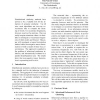Free Online Productivity Tools
i2Speak
i2Symbol
i2OCR
iTex2Img
iWeb2Print
iWeb2Shot
i2Type
iPdf2Split
iPdf2Merge
i2Bopomofo
i2Arabic
i2Style
i2Image
i2PDF
iLatex2Rtf
Sci2ools
NLE
2010
2010
A non-negative tensor factorization model for selectional preference induction
Distributional similarity methods have proven to be a valuable tool for the induction of semantic similarity. Up till now, most algorithms use two-way cooccurrence data to compute the meaning of words. Co-occurrence frequencies, however, need not be pairwise. One can easily imagine situations where it is desirable to investigate co-occurrence frequencies of three modes and beyond. This paper will investigate a tensor factorization method called non-negative tensor factorization to build a model of three-way cooccurrences. The approach is applied to the problem of selectional preference induction, and automatically evaluated in a pseudo-disambiguation task. The results show that non-negative tensor factorization is a promising tool for NLP.
| Added | 29 Jan 2011 |
| Updated | 29 Jan 2011 |
| Type | Journal |
| Year | 2010 |
| Where | NLE |
| Authors | Tim Van de Cruys |
Comments (0)

